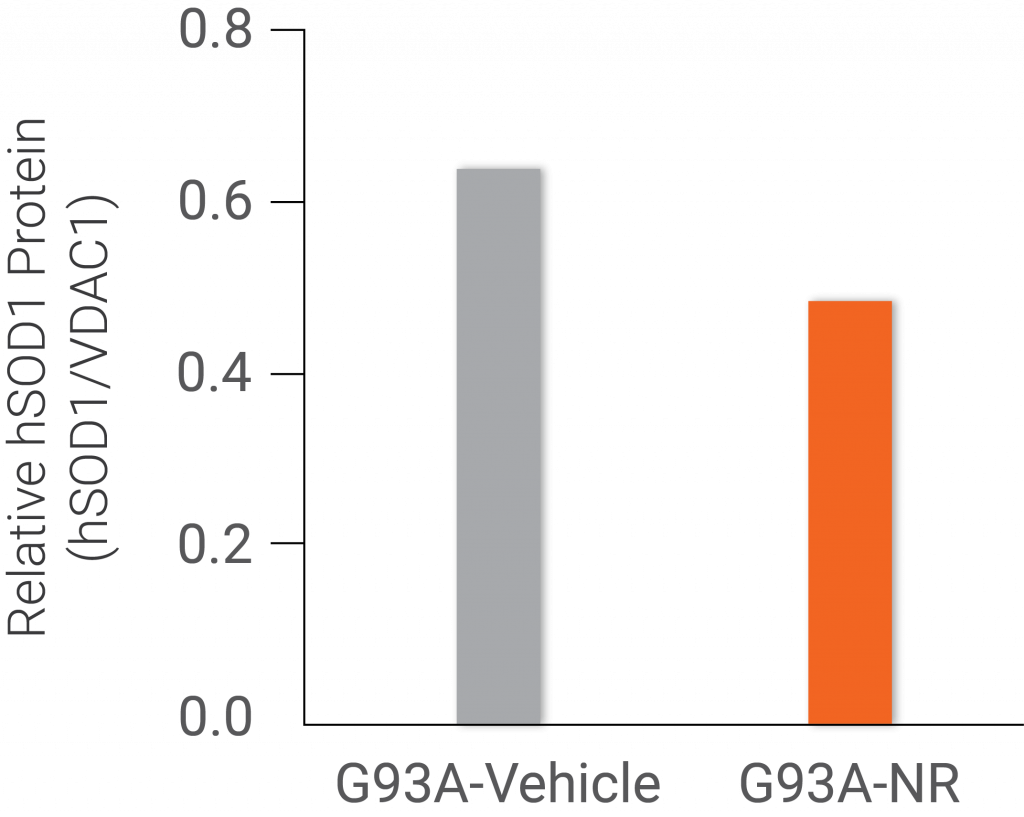Amyotrophic lateral sclerosis (ALS), also called Lou Gehrig’s disease, is caused by progressive cell deterioration throughout the nervous system in motor neurons that control our muscle movements, prompting muscle weakness and eventual paralysis. Still, we don’t have effective drugs for treating ALS. The diminishing levels of a vital molecule called nicotinamide adenine dinucleotide (NAD+) is seen in many neurological diseases. In adult mice, increasing NAD+ levels promotes the maintenance of brain stem cells, which are affected in ALS and are critical for the process of forming new neurons. Yet, the effects of increasing NAD+ levels on the nervous system in ALS has been unclear.
Researchers from the Affiliated People’s Hospital of Nanchang University in China published an article in the International Journal of Biological Sciences showing that mice treated with the NAD+ precursor nicotinamide riboside (NR) in their drinking water exhibited better motor function. The research team observed that supplementation with 400 mg/kg/day of NR enhanced the proliferation and migration of neural stem cells in the brain of ALS mice but did not postpone the onset of disease or extend the mouse lifespan. “NR may be a viable clinical therapeutic scheme of translational medicine for ALS and other neurodegenerative diseases,” said the authors in their study.
The regulation of proteins in the mitochondria, the primary site of energy generation in cells, has been proposed as important in the age-related decline. Recent studies have implicated a mitochondrial stress response as a link between mitochondria and aging in different organisms. The consumption of NAD+ is a related pathway to mitochondrial damage in many situations, and replenishing NAD+ can counteract mitochondrial stress.
Research shows that brain stem cells, which are necessary for new neuron formation, are affected in ALS mice, and there are several lines of evidence supporting NAD+ supplementation’s role for reestablishing the function of brain stem cells during aging. Collectively, this suggests that increasing NAD+ levels by administering NAD+ precursors might be a therapeutic option against ALS disease by affecting dysfunctional mitochondria and adult neuron production.
In this study, the investigators showed that aging ALS mice had diminishing levels of NAD+ and that NR treatment had several therapeutic effects, like improved motor function. The research team observed that the NR treatment significantly attenuated the ALS-induced loss of neural stem cells. In the meantime, administering NR also continually rejuvenated the pool of immature neurons, suggesting that the NR supplementation promoted proliferation and migration of neural stem cells in the brain of ALS mice.

NR supplementation promoted the clearance of the mutated protein hSOD1 that causes ALS in mice. Bar graphs show the quantification of relative protein levels of the neurotoxic mutated protein hSOD1 in the mitochondria of mice (G93A) treated with nicotinamide riboside (NR) or without (vehicle) (Zhou Int J Biol Sci. | 2020).
The investigators observed that the balance of proteins in mitochondria, indicative of its functionality, was disrupted in the ALS mouse brains. They observed that the mutated protein in ALS called hSOD1 (human superoxide dismutase 1) aggregated in the mitochondria of the nervous system and that NR supplementation promoted the clearance of the mutant and toxic hSOD1 protein from the nervous system in ALS mice. They found that mitochondrial stress response proteins increased in abundance in the brain of ALS mice after treatment with NR. “Our observations provided evidence that the recharging of intracellular NAD+ by providing NR might decrease the neurotoxic impacts of protein aggregates of mitochondria in the brain of ALS mice,” said the investigators in their study.

NR treatment increases the presence of new neurons in the brains of ALS mice. Bar graphs showed the quantitative analysis of newborn neurons (DCX+ cells), an indicator of adult neurogenesis, in mice with the neurotoxic protein hSOD1 (G93A) to mode ALS and those without (Wt). The researchers looked at two areas known for neurogenesis: the subgranular zone (SGZ) and the olfactory bulb (OB) (Zhou Int J Biol Sci. | 2020).
Although the investigators observed enhanced motor function, clearance of the neurotoxic hSOD1 protein, and mitochondrial stress response, NR treatment did not delay a key indicator of disease onset, tremors, or extend the lifespan of ALS mice. The investigators propose that, although studies have shown NAD+ intervention increases mouse lifespan, they did not see an increased lifespan in ALS mice treated with NR possibly due to insufficient supplementation or treatment regimen differences.
These findings reveal that NR administration activates the mitochondrial stress response to clear toxic proteins and improves the adult neuron production in the brains of ALS mice along with some motor function. “We conclude that the NR…improves adult neurogenesis in the brain of [ALS] mice, and NR may be a viable clinical therapeutic scheme of translational medicine for ALS and other neurodegenerative diseases,” said the investigators in their study.